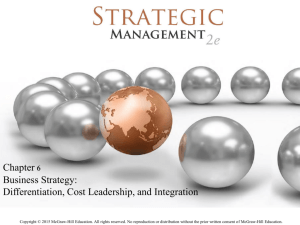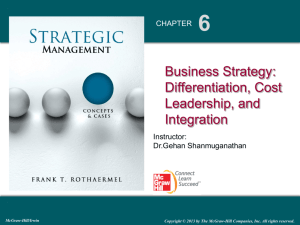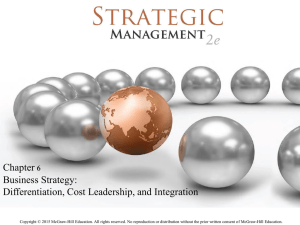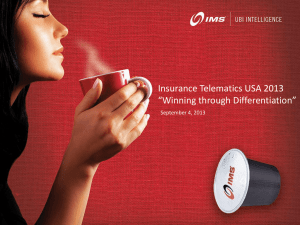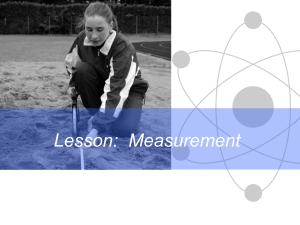6 Business Strategy: Differentiation, Cost Leadership, and Integration
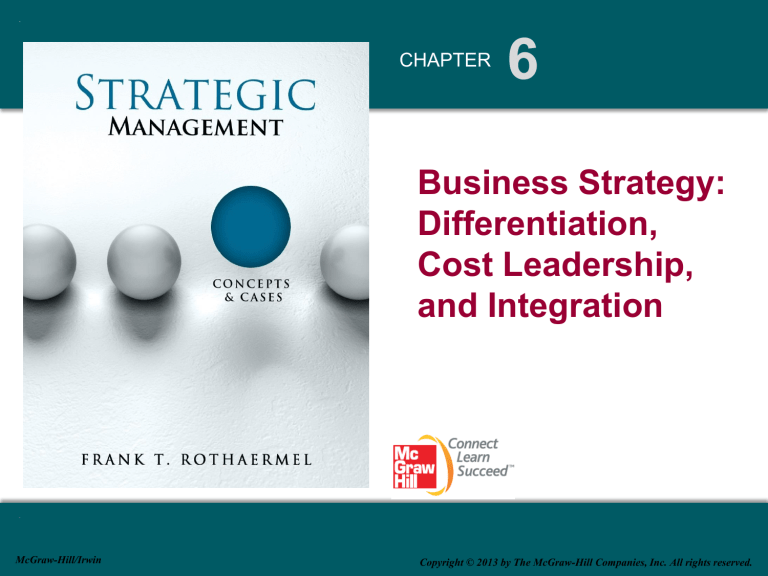
McGraw-Hill/Irwin
CHAPTER
6
Business Strategy:
Differentiation,
Cost Leadership, and Integration
Copyright © 2013 by The McGraw-Hill Companies, Inc. All rights reserved.
Part 2 Strategy Formulation
6 –2
LO 6-1 Define business-level strategy and describe how it determines a firm’s strategic position.
LO 6-2 Examine the relationship between value drivers and differentiation strategy.
LO 6-3 Examine the relationship between cost drivers and cost-leadership strategy.
LO 6-4 Assess the benefits and risks of cost-leadership and differentiation business strategies visà-vis the five forces that shape competition.
LO 6-5 Explain why it is difficult to succeed at an integration strategy.
LO 6-6 Evaluate value and cost drivers that may allow a firm to pursue an integration strategy.
LO 6-7 Describe and evaluate the dynamics of competitive positioning.
6 –3
Chapter Case 6
Trimming Fat at Whole Foods Market
• Whole Foods…Business Strategy Revitalization
Started as small natural-foods store 1980
Became market leader; differentiation through organics and quality
Competitive advantage through 2008
• CEO John Mackey: Refocused Mission, Reduced Costs
6 –4
Business Strategy and Competitive Advantage
• A business-level strategy is an integrated and coordinated set of commitments and actions designed to provide value to customers and gain a competitive advantage by utilizing core competencies in specific individual product markets.
6 –5
Business-Level Strategy:
How to Compete for Advantage?
• Answer the “Who, What, Why, and How”
Who - which customer segments to serve?
What needs, wishes, desires will we satisfy?
Why do we want to satisfy them?
How will we satisfy customers’ needs?
• Details actions managers take in quest for competitive advantage
Single product or group of similar products
6 –6
EXHIBIT 6.1
Industry and Firm Effects Jointly
Determine Competitive Advantage
6 –8
Business Strategy and Competitive Advantage
• Two fundamental questions:
How do you generate advantage?
How do you sustain advantage?
• Key idea for sustainability is “ barriers to imitation.”
How long will it be before the first rival imitates the first mover?
How fast does new imitation occur once it starts?
These two factors determine appropriability
.
6 –9
Business Strategy and Competitive Advantage
• Does market share generate competitive advantage?
The computer industry is an excellent example of the lack of correspondence between market share and profit rates.
IBM was a clear market leader in terms of market share but had only mediocre economic performance relative to its rivals. High market share is no guarantee of high rates of profitability.
6 –10
Business Strategy and Competitive Advantage
• Does market share generate competitive advantage?
Perhaps high market share causes high profit rates.
But it could equally well be that there is a third factor
(e.g., good service capabilities at Caterpillar), unobserved by us, that causes both high profitability and high market share.
In this case, we would see a correlation between profitability and market share but no causal explanation .
Business Strategy and Competitive Advantage
• When can market share work to generate and sustain an advantage?
Scale economies combined with high exit costs may make market share a defensible advantage.
6 –12
Sustainable Competitive Advantage
•
Costly Duplication due to:
Historical Conditions;
Uncertainty;
Social Complexity; and
Property Rights Protection.
6 –13
Business Strategy and Competitive Advantage
• An organization’s knowledge or expertise can lead to sustainable advantage if:
The knowledge is tacit rather than articulable;
Tacit Knowledge: “We know more than we can tell.”
Tacit Skills: Riding a bike, swimming, “learning by doing,” which is critical for maintaining a manufacturing base
The knowledge is not observable in use;
The knowledge is (socially) complex, rather than simple.
6 –14
Strategic Position
• Determined by Firm’s Business-Level Strategy
Two primary competitive levers:
Value (V)
Cost (C)
• Economic Value Created: (V-C)
The greater (V-C) = Competitive Advantage
• Strategic Position Based on :
Value creation
Cost
6 –15
Forms of Competitive Advantage
Competitive
Advantage
Cost
Advantage
Similar Product
At Lower Cost
Price Premium
From Unique Product
Differentiation
Advantage
6 –16
EXHIBIT 6.2
Strategic Position and Competitive Scope:
Generic Business Strategies
6 –17
LO 6-1 Define businesslevel strategy and describe how it determines a firm’s strategic position.
LO 6-2 Examine the relationship between value drivers and differentiation strategy.
LO 6-3 Examine the relationship between cost drivers and cost-leadership strategy.
LO 6-4 Assess the benefits and risks of cost-leadership and differentiation business strategies visà-vis the five forces that shape competition.
LO 6-5 Explain why it is difficult to succeed at an integration strategy.
LO 6-6 Evaluate value and cost drivers that may allow a firm to pursue an integration strategy.
LO 6-7 Describe and evaluate the dynamics of competitive positioning.
6 –18
$
Types of Competitive Advantage
Buyer value generated (willingness to pay)
Costs incurred (including opportunity cost of capital)
Value
Created
Industry average competitor
Successful differentiated competitor
Successful low-cost competitor
Competitor with dual advantage
© 2005 Mara Lederman, Rotman School of Management
Differentiation Advantage
• Differentiation Advantage , a concept developed by economist Joan Robinson , occurs when a firm is able to obtain from its differentiation a price premium in the market which exceeds the cost of providing differentiation.
6 –22
EXHIBIT 6.3
Value Drivers: Differentiation
• Differentiation:
Product features, customer service, customization, and complements
Competitive advantage = economic value created (V-C) > competitors
Marriott line of Hotels
6 –23
STRATEGY HIGHLIGHT 6.1
Toyota: From “Perfect Recall” to “Recall Nightmare”
• Toyota’s strategic challenges….
Launched Lexus 1989
Luxury car segment dominated by Mercedes-Benz, BMW, Cadillac
LS400 line required recall a little over a year after launch
Turned threat into opportunity to establish reputation for superior customer service
Two years after launch Lexus ranked first on quality and customer satisfaction by J.D. Powers
2010 Toyota has largest recall in automotive history
Needed to exhibit superior customer responsiveness again
8 million vehicles recalled was much more challenging
1 –24
EXHIBIT 6.4
Cost Drivers: Cost-Leadership
• Cost Leadership:
Cost of input factors, economies of scale, and learning-curve and experience-curve effects
Competitive advantage = economic value created (V-C) > competitors
Walmart vs. Kmart
Dell vs. Compaq, Gateway, & HP
6 –25
STRATEGY HIGHLIGHT 6.2
Ryanair: Lower Cost than the
Low-Cost Leader!
• The “Southwest Airlines of Europe”
“Lowest-cost airline in the world”
No window shades on older planes, seats don’t recline, etc.
Fares as low as $8
Numerous fees and surcharges: pillows, blankets, check-in, etc.
20+% of revenues flow from ancillary services
1 –26
Ryanair Sample Revenue Calculation
1 Bottle of Water,
$3.50 Ad Revenue, $2 Ticket Price, $8
Priority Boarding, $4
Pillow & Blanket, $5
Subsidy from More
Expensive Flights,
$5.50
Credit Card Fee, $6
Online Check-in, $7.50
Checking Two Bags,
$45
6 –27
EXHIBIT 6.5
Economies of Scale and Diseconomies of Scale
30
"Big Box" Retailers' Advantage
Box 2 x 2 x 2
Volume 8
Box 3 x 3 x 3
Volume 27
• Cube-Square Rule:
Each dimension increases 50% (2 goes to 3) BUT
Each volume increases 237.5% (8 goes to 27) !!
6 –31
Learning Curve: Sources of Gain
Need less time to instruct workers
Workers become more skillful in their movements
Develop better operation sequences
Machines and tooling are continually improved
Rejections and rework decrease
Management controls improved
Engineering changes become less frequent
Cost-effective improvements in product design
Enriched knowhow in managing and operating business
More efficient inventory handling and distribution methods
6 –32
Limits of “Learning Curve” Advantages
Copying and reverse engineering of products;
Hiring a competitor’s employees;
Purchasing the know-how from consultants;
Obtaining the know-how from customers;
Experience advantages are often nullified by product obsolences and innovations.
6 –33
Learning Curve
• The following discussion and applications focus on direct labor hours per unit, although we could as easily have used costs. In developing a learning curve, we make these assumptions:
Direct labor requirements will decrease at a declining rate as cumulative production increases.
The reduction in time will follow an exponential curve. In other words, the production time per unit is reduced by a fixed percentage each time production is doubled. We can use a logarithmic model to draw a learning curve. The direct labor required for the nth unit, k n
, is
• k n
= k
1 n b where
• k
1
= direct labor hours for the first unit
• n = cumulative number of units produced
• b = log r/log 2
• r = learning rate
6 –34
Learning Curve
• Example: The Bellweather Company has a contract for 60 portable electric generators. The labor-hour requirement for manufacturing the first unit is 100. With that as given, Bellweather planners develop an aggregate capacity plan using learning-curve calculations. They use a 90 percent learning curve, based on previous experience with generator contracts .
• The labor requirement for the second generator is:
• k
2
= k
1 n b
• = 100 (2) log 0.9/log 2
• = 100 (2) -.152
• = 100 (.9) = 90 hours
• This result for the second unit, 90, is expected, since for a 90% learning curve there is a 10% percent learning between doubled quantities.
6 –35
Learning Curve
• Example: The Bellweather Company
For the 8th unit,
= 100 (8) -.152
= 100 (0.729) = 72.9 hours
This result is also obtained by 100 (.9) (.9) (.9) =
72.9 hours.
• Learning curves can be used for:
Bid Preparation
Financial Planning
Production Scheduling
6 –36
The Learning Curve
Aircraft Assembly (1925-57): 80%
Calculator (1975-78): 74%
EXHIBIT 6.6
Gaining Competitive Advantage Through
Learning and Experience Curves
6 –38
LO 6-1 Define businesslevel strategy and describe how it determines a firm’s strategic position.
LO 6-2 Examine the relationship between value drivers and differentiation strategy.
LO 6-3 Examine the relationship between cost drivers and cost-leadership strategy.
LO 6-4 Assess the benefits and risks of cost-leadership and differentiation business strategies vis-
à-vis the five forces that shape competition.
LO 6-5 Explain why it is difficult to succeed at an integration strategy.
LO 6-6 Evaluate value and cost drivers that may allow a firm to pursue an integration strategy.
LO 6-7 Describe and evaluate the dynamics of competitive positioning.
6 –39
EXHIBIT 6.7
Competitive Positioning and the Five Forces
6 –40
LO 6-1 Define businesslevel strategy and describe how it determines a firm’s strategic position.
LO 6-2 Examine the relationship between value drivers and differentiation strategy.
LO 6-3 Examine the relationship between cost drivers and cost-leadership strategy.
LO 6-4 Assess the benefits and risks of cost-leadership and differentiation business strategies visà-vis the five forces that shape competition.
LO 6-5 Explain why it is difficult to succeed at an integration strategy.
LO 6-6 Evaluate value and cost drivers that may allow a firm to pursue an integration strategy.
LO 6-7 Describe and evaluate the dynamics of competitive positioning.
6 –41
EXHIBIT 6.8
Avon Pursuing an Integration Strategy
6 –42
EXHIBIT 6.9
Value and Cost Drivers
6 –43
Integration Strategy – Corporate Level
• Conglomerates can coordinate above the SBU level
Tata Group from India
2008 bought Jaguar & Land Rover
– Prestigious differentiated products
2009 Tata Motors creates a Nano car
– Lowest-priced car in the world!
– Zero to 60 mph in 30 seconds
– No radio or glove box
– Targets bicyclists to move to cars
6 –44
LO 6-1 Define businesslevel strategy and describe how it determines a firm’s strategic position.
LO 6-2 Examine the relationship between value drivers and differentiation strategy.
LO 6-3 Examine the relationship between cost drivers and cost-leadership strategy.
LO 6-4 Assess the benefits and risks of cost-leadership and differentiation business strategies visà-vis the five forces that shape competition.
LO 6-5 Explain why it is difficult to succeed at an integration strategy.
LO 6-6 Evaluate value and cost drivers that may allow a firm to pursue an integration strategy.
LO 6-7 Describe and evaluate the dynamics of competitive positioning.
6 –45
The Dynamics of Competitive Positioning
• Strategic Positions need to change over time
eBay withdrew from selling new goods & sold Skype
• Productivity Frontier
Value-cost relationship
Captures the best practices at a point in time
• Mobile Devices
2005 – Apple differentiator, Dell cost leader
2010 – Apple still differentiator, HP moving to successful integrator, Dell shifting toward integrator
6 –46
EXHIBIT 6.10
The Dynamics of Competitive
Positioning: Apple, HP, and Dell
6-47
6 –48
